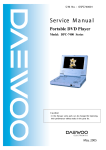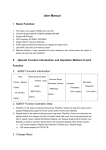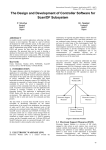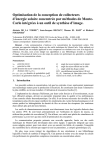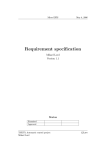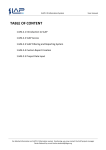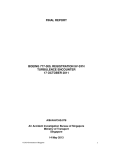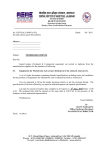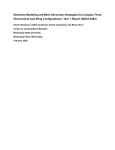Download Study on I2C Protocol for Implementation on FPGA
Transcript
International Journal of Computer Applications (0975 – 8887) National Conference on Emerging Trends in Advanced Communication Technologies (NCETACT-2015) Study on I2C Protocol for Implementation on FPGA Shital Mahajan Department of Electronics and Telecommunication Engineering (VLSI & Embedded Systems) D. Y. College of Engineering, Akurdi, Pune ABSTRACT In this study, having a study of implementation of I2C protocol on FPGA. This study of project also contains learning anew platforms, tools like I2C bus configuration Xilinx 14.1, Verilog. I2C protocol has easy communication without any data loss. It also has high speed compared to other protocols. I2C uses only two wire for communication. It also increases data transfer rate. I2C is used in data observation for accuracy and efficiency. The design method will be developed in Verilog, simulated on Xilinx 14.1 and will be implemented on FPGA board. General Terms Protocol, Coding, Interfacing. Keywords IC24C02, FPGA, I2C, master, serial data communication, slave, Spartan 3, Xilinx 1. INTRODUCTION In the field of serial data communication, there are some protocols like RS-232,RS-422, RS-485, SPI (Serial peripheral interface), and For interfacing high speed and low speed peripherals there is Micro wire. These protocols require number of pin connections in the IC(Integrated Circuit) for serial data communication to be taken place, There is a requirement of less amount of pin connection for serial data transfer as the physical size of IC have decreased over the years. Protocols like USB/SPI/Micro wire and also mostly UARTS are all only ‘one point to one point’ data transfer bus systems. They all use multiplexing of the data path and to send messages to service multiple devices. To overcome the same problem Phillips introduced the I2C protocol which needs only two lines to communicate. The I2C protocol was developed by Philips Semiconductors with purpose for allowing faster devices to communicate with slower devices As well as also allow devices to communicate with each other above a serial data bus without any data loss. In this there is a model of I2C bus controller. This I2C controller will be designed using verilog in xilink 14.1 and targeted in Spartan-3. In this system, presents there is an experimental design and implementation of serial data communication by using I2C master and slave bus controller with the help of a FPGA. The I2C master will initiate the data transmission and acceptable slave responds to it. Here 24C02 IC as a slave is to be implemented. Also the ADC, EEPROM, and RTC can be used to interface for communication among Slave and Master. So as It remains for minimizing system-level interconnect. Moreover transmitting information over the I2C bus will increase system. 2. DESIGN AND IMPLEMANTATION STUDY A] I2C protocol: This is also known as Inter Integrated Circuit Protocol, i.e. it is helpful when there is a need of Communication between two ICs which are not present in common Board. It is very simple to design. It needs only 2 wires for the communication Process. Hence this Protocol is also known as 2-Wire Communication Protocol. The I2C protocol was developed by Philips Semiconductors with purpose for allowing faster devices to communicate with slower devices as well as also allow devices to communicate with each other above a serial data bus without any data loss.[4][5] 2.1 I2C Bus Specification The I2C Controller Bus is a two-wire, bi-directional serial bus that provides a simple and efficient method of data transmission over a short distance between many devices. I2C provides good support for communication with various slow, on-board peripheral devices that are accessed intermittently, while being extremely modest in its hardware resource needs. It is a simple, low bandwidth, short distance protocol. I2C is easy to use to link multiple devices together since it has a built-in address [1].The two I2C signals are serial data (SDA) and serial Clock (SCL) as shown in Figure. The device that initiates a transaction on the I2C bus is termed the master. The master normally controls the clock signal. A device being addressed by the master is called a slave. [1][2] The following diagram shows I2C bus configuration using masters and slaves. Figure 1: I2C bus configuration using masters and slaves The I2C protocol supports multiple masters, but most of the system designs include only one. There may be one or more slaves on the bus. Anyone of masters and slaves can receive and transmit data bytes at a time. Standard I2C devices work up to 100Kbps, while for fast-mode devices operate at up to 400Kbps. Most of the fast-mode devices are available today support 400Kbps operation. Higher-speed operation may allow I2C to have with the rising demand for bandwidth in multimedia as well as other applications. [1] 2.2 I2C Characteristics The ideal architecture with I2C has the characteristics high performance, flexibility, easy upgradability, Low development cost[3]. The SDA and SCL lines are bidirectional lines connected to a positive voltage supply 5 International Journal of Computer Applications (0975 – 8887) National Conference on Emerging Trends in Advanced Communication Technologies (NCETACT-2015) through a pull up resistor. The bus is free when these lines are `high'. The data on the SDA line is valid only when the SCL line is `high'. Change of data is allowed when SCL line becomes `low'. During data transfer, the master generates the START and STOP conditions, which are unique conditions and are shown in Figure [2]. Figure 2: START and STOP conditions 2.3 I2C Bus Controller Design I2C protocol consists of four parts 1)START signal generation,2) Slave address transfer, 3) Data transfer,4) STOP signal generation[1]. I2C controller is to be implemented. It is for minimizing system level interconnects. Also transmitting the information over I2C bus will improve system performance. Following is the block diagram of communication between Master and Slave. FPGA will be used for the project as it has parallel processing feature. This project will demonstrate how I2C Master Controller (Master) transmits and receives data to and from the Slave. For the implementation and interfacing of I2C master controller to slave over FPGA Verilog language will be used. This will simplifies the system level design. In this study, an experimental design and implementation of serial data communication by using I2C master and slave bus controller will be designed with the help of an FPGA.[6] This module will be designed in Verilog HDL. The design will be created using Xilinx platform studio 14.1. It can be used in the applications such as embedded system, mobile phones, motherboard, set top boxes, DVD, PDA's or any other electronic devices. Figure 4 is the block diagram of I2C as a master and 24C02 IC as a slave of proposed System. In which slave i.e. memory IC 24C02 is connected to master i.e. FPGA.[6][7] In the I2C master controller, I2C start/stop is a first block in which start and stop condition will be generated. At the time of SCL line is high, there should be two conditions of SDA line i.e. low to high and high to low. So at SDA line is low to high then a start condition will be generated and at high to low then stop condition will be generated. Arbitration unit monitors whether bus is in ideal condition or not. If SDA and SCL both are high then bus is also high that means bus is in ideal condition. Microprocessor will be connected to switches and LEDs. I2C controller state machine controls all units. I2C Synchronizer and I2C clock generator will set frequency between 100Kbps to 400Kbps. 3. CONCLUSION Figure 3: I2C bus architecture. It consists of a master and a slave connected using I2C bus. The SDA line is connected to a positive supply voltage through a pull up resistor. The SCL line is not connected to a pull up resistor as there is only one master. For designing the I2C master controller a finite state machine (FSM) is required. We can easily implement finite state machine by writing VHDL or Verilog code [1]. For this study I2C is to be used due to its simplicity of design and easy maintenance. Also has the characteristics i.e. high performance, flexibility, low development cost.FPGA will be used for the project as it has parallel processing feature. This will simplifies the system level design an experimental design and implementation of serial data communication by using I2C master and slave bus controller will be designed with the help of an FPGA. This project will be designed in Verilog HDL. The design will be created using Xilinx platform studio 14.1. With the help of this designed module the applications can be designed. It can be used in the applications such as embedded system, mobile phones, motherboard, set top boxes, DVD, PDA’s or any other electronic devices. 4. REFERENCES [1] B. H. Soni, Mr. J. J. Patel Design and implementation of i2c bus controller using verilog. Journal of Information, Knowledge and Research in Electronics and Communication Engineering, 02:520, 2012. [2] Um10204 i2c -bus specification and user manual Rev.4 [3] JayantMankar, ChaitaliDarode, KomalTrivedi, MadhuraKanoje, PrachiShahare. REVIEW OF I2C PROTOCOL. International Journal of Research in Advent Technology, Volume 2, Issue 1, January 2014,474 [4] THE I2C BUS SPECIFICATION VERSION 2.1 January, 2000, Philips Semiconductors. [5] Philips Semiconductor. I2c bus specification. Version 2.1, January 2000. Figure 4: The I2C Master Controller Block Diagram IJCATM : www.ijcaonline.org [6] Jai Karan Singh. Design and implementation of i2c master controller on fpga using vhdl. Aug-Sep 2012 6


